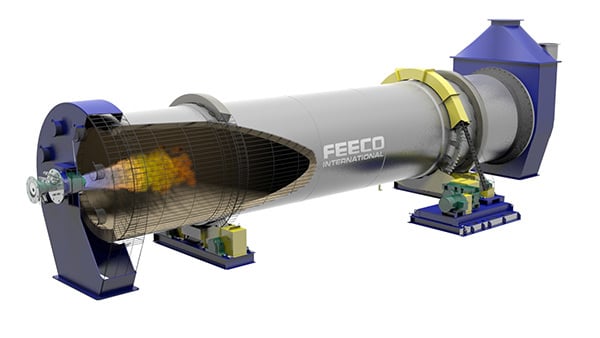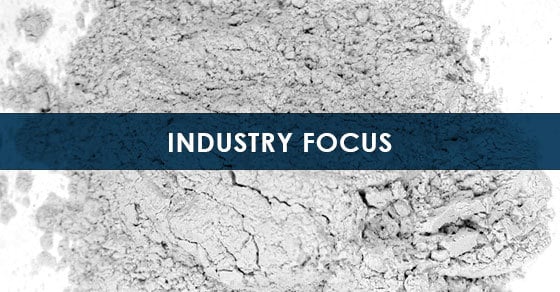Diatomaceous earth, also known as diatomite or kieselguhr, is an industrial mineral essential to everything from producing beer and wine, to extending and whitening plastics.
The diverse application of diatomaceous earth demands great variation in the material as a feedstock, and producing the different qualities and types of diatomaceous earth required by industry relies on a key thermal treatment: calcination. Widely employed in the processing of diatomaceous earth, calcination is used to manipulate many of the properties that allow its use in everything from filtering agents to absorbents.
Note: While the industry uses the term “calcination” to refer to the thermal treatment of diatomaceous earth, by definition, what actually occurs with the diatomaceous earth is technically a sintering process.¹
About the Calcination of Diatomaceous Earth
Diatomaceous earth products are broken into three categories or grades: natural, calcined (sometimes called straight calcined), and flux calcined. While natural diatomaceous earth boasts many favorable properties, producers often rely on calcination to enhance the qualities that make diatomaceous earth unique. Of the three grades, calcined diatomaceous earth makes up the largest share of the market (about half), primarily owing to its capabilities as a superior filtering agent.
Calcination is employed throughout the mineral processing industry to facilitate chemical reactions and phase changes in materials through controlled thermal treatment. In the case of diatomaceous earth, calcination is used to cause the destruction of the material’s fine structure, along with several other objectives that make it better suited for end markets:¹
- A reduction of surface area
- An increase in specific gravity
- Improved hardness
- Removal of organic components
- Increased particle size distribution (formation of agglomerates through sintering)
- Partial conversion of opalune silica to cristobalite
- A change in color
- Increased flow rate when used as a filtering agent
Ultimately, the results is a product with a higher bulk density, lower surface area, and increased void volume.²
Flux Calcination of Diatomaceous Earth
Flux calcining, in which the material is calcined at higher temperatures in the presence of a fluxing agent (typically soda ash), takes the calcination process a step further, enhancing these effects beyond what can be achieved through straight calcination. Of special importance is that flux calcining produces larger agglomerates and is white in color.¹
Calcination, whether in the presence of a fluxing agent or not, is an adaptable process; process conditions can be manipulated to affect the properties of the end product in certain ways. Depending on the intended application for a given sample of diatomite, other important properties influenced through the calcination process might include:
- Brightness
- Absorptive capaity
- Refractive index
- Inertness
- Chemical stability
- Potential for dust generation
- And more…
The Calcination Process
Upon mining, diatomaceous earth is milled and if necessary, dried in a rotary dryer, at which point it can be calcined. The calcination process is carried out in a rotary kiln (sometimes referred to as a calciner).
Material is fed into the rotary kiln, which is typically of the direct-fired counter-current configuration.

3D rendering of a FEECO Direct-Fired Counter-Current Rotary Kiln (Calciner)
As is the case with most calcined materials, the temperatures and retention times at which diatomaceous earth is calcined differs based on the intended end use, as different process parameters produce a variation in results.
Straight calcination is typically carried out at temperatures between 870-1100°C, while flux calcination is conducted at temperatures up to 1200°C.¹
Developing a Calcination Process for Diatomaceous Earth
Diatomaceous earth is typically accompanied by a presence of several other minerals and sediments. This variation can make processing parameters difficult to predict, as each component can influence the calcination process in its own way, or in a different way when combined with some of the other components present. This makes testing a crucial step in developing a successful calcination process.
By testing a representative sample of diatomaceous earth using batch- and pilot-scale rotary kilns such as those in the FEECO Innovation Center, critical process data about calcining specific sources of diatomaceous earth can be revealed. This typically includes:
- Residence/Retention time
- Temperature profiles
- Gas sampling & analysis
- Energy requirements
- Flow rates
- Kiln slope and speed
- Processing atmosphere
- Quantity of fluxing agent needed
Through manipulation of these parameters, end product characteristics can be modified, allowing processors to identify the specific combination of parameters necessary to produce a product with the precise specifications they’re looking for. This data is then used to scale up the process and design a commercial-scale rotary kiln.
Testing is also available for the drying and agglomeration of diatomaceous earth as well.
Conclusion
Diatomaceous earth plays a pivotal role in bringing so many of the products we depend on to market. The high quality and unique specifications used to tailor diatomaceous earth to a specific process are often the result of a well-designed calcination process. Through calcination, processors can manipulate a range of quality factors, allowing them to produce a diatomaceous earth product with the precise specifications their market demands.
Backed by extensive testing capabilities in the FEECO Innovation Center, FEECO is able to supply the industry’s most effective and robust custom rotary kilns. For more information on our rotary kilns for diatomaceous earth or our testing capabilities, contact us today!



